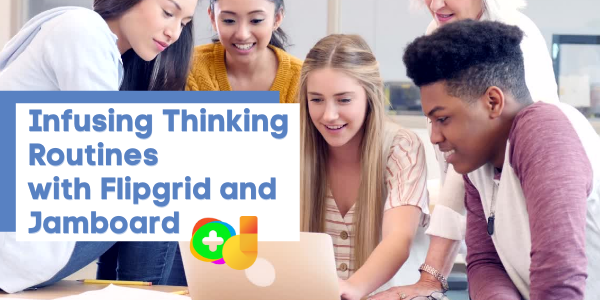The Infused Classroom Blog
Pairing Thinking Routines with Technology
Share Post
Great pedagogy deserves to be paired with really meaningful technology to empower the learning experience. In this post the focus is on purposefully infusing a Thinking Routine - in this example - Circle of Viewpoints with both Flipgrid and Jamboard.
Before we talk about the tools - we need to focus in on the learning by understanding what Thinking Routines are and how they help students think more deeply about the content
Watch the Tik Tok on Infusing Circle of Viewpoints Thinking Routine with Flipgrid and Jamboard
What is a Thinking Routine?
Thinking Routines are a set of structures (or routines) students use to think more critically about ideas. This facilitates learning as students unpack information and/or thoughtfully ask questions about topics, dig into content around what they are learning in ANY subject area.
A Thinking Routine is a way of looking at text or information in a more thoughtful, deliberate fashion. As students master the routine, they also develop, what Project Zero calls, a ‘sensitivity’ to begin to use these routines in their everyday lives - outside of the classroom. If done correctly, the new thinking becomes habitual. The brain naturally develops an inclination toward this effective process when unpacking new content. Thus, learning is more intrinsic and intuitive rather than driven by teacher created questions. Bottom line, these routines are meant to eventually help students learn to think on their own and understand how to learn, access, unpack and make meaning out of new information .
The Project Zero website outlines the Thinking Routines and invites learners of any age to begin thinking by:
- asking deep questions
- making connections
- coming up with explanations
- challenging those explanations
- exploring alternative perspectives.
By using thinking routines, learners develop “thinking moves” that they can apply to all areas of schooling and life. Learners build a repertoire of thinking moves that, if used enough, manifest in the development of an organized way of managing information and new content. In other words, by using these routines in class students develop habits of observing, analyzing and questioning that help students make meaning of text, new concepts and complex information.
When learners make meaning in this way, they are more likely to make deeper connections to their learning. For instance, a student who uncovers meaning via “thinking moves” accesses information in a more personal and an organized fashion that allows them to connect to content; a learner reading complex text may be better able to make a meaningful connection to self (experience, prior knowledge), another text, or the world at large (current events).
On their own, these thinking routines are very powerful. However, as always, technology can enhance this process! Integrated technology facilitates the opportunity for students to share their ideas and learn from one another - empowering this activity with a jolt of metacognition and social learning.
Example: Infusing Circle of Viewpoints Thinking Routine with Technology
Download Resources: Jamboard and Flipgrid Infused Thinking Routine
Infusing Circle of Viewpoints Thinking Routine with Technology
Download Resources HERE
Technology Infusions: Flipgrid and Jamboard
- First, have students use this Jam to unpack their thinking.
- Next, have them go to Flipgrid and take on that viewpoint, recording and explaining it as if they were that person, character, idea or historical figure - from that unique perspective.
- Have students watch at least 3-5 other student responses and comment on those videos from the perspective of their character.
- Finally, discuss how hearing these different viewpoints affected how students thought about the original idea or lesson.
Purpose: What kind of thinking does this routine encourage?
This routine helps students see and explore multiple perspectives. It helps them understand that different people can have different kinds of connections to the same thing and that these different connections influence what people see and think.
Thinking routines are one of the best ways to help students develop their own habits of mind and to better understand how to learn. But when we add technology we allow students to not only develop a repertoire of thinking moves, but also teach them how to share those moves with a wider audience.
Flipgrid houses student responses, varied perspectives and outlooks in one place. The medium is easily accessible and allows students to use creativity in recording responses, listen to what they themselves had to say and compare their point of view to their peers. Thus, Flipgrid is not only a stellar vehicle for academic discourse, assessment and “thinking aloud”, it helps students develop the equally important attributes of empathy and confidence.


